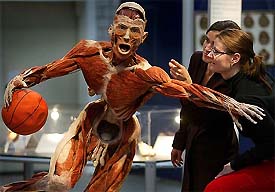
Premier Exhibitions, which produced "Bodies," obtained the bodies and body parts from the Dalian Medical University of Plastination Laboratories in China.
The Chinese laboratories prepare the skinned bodies and body parts via polymer preservation, also called plastination or plasticization. In this process body water and fats are replaced with liquid silicone rubber. The laboratory supplies the bodies to human-anatomy exhibits around the world.
The corpses and body parts used in "Bodies: TheExhibition" were "legally obtained" from various medical schools and universities in China, Glover said. In addition to being a spokesperson for "Bodies," Glover is a professor emeritus of anatomy and cell biology at the University of Michigan in Ann Arbor.
"It is standard legal practice in both the United States and China that unclaimed or unidentified remains are made available for medical education, which is one of the key goals of our exhibition," he said.
But Arthur Caplan, director of the Center for Bioethics at the University of Pennsylvania in Philadelphia, is uncomfortable with the practice. Regardless of the law, the use of unclaimed bodies in human-anatomy exhibits is questionable, Caplan says.
"There's a fine line between education and exploitation in these kinds of exhibits. And you only want people to be displayed if you have their consent, not the consent of a third party," he said.
Since the bodies are either unclaimed or unidentified, obtaining consent was impossible, Glover said.
I remember from my Gross Anatomy class in the first year fo medical school, how we learned from our cadavers with the utmost of respect at all times. Those people, and their families, had left their bodies to science in the good faith that they would be used for the higher purpose of science. We even had a nondenominational service at the end of the course, led by the school's chaplain, to thank them, and say goodbye.
I recently heard about "Bodies: The Exhibition" which has been in Manhattan. I have to say that my impression is that this is sensationilistic, and the focus is on novel poses, and not on learning science, or teaching anatomy. I am further dismayed that the bodies were imported from China, where the laws apparently are not be as strict for protecting the dead.
I daresay that I think these folks behind the show are only motivated by two things. The first is the "shock value" of their exhibit. The second is how many voyeutistic individuals will pay $25 to glimpse at a corpse encased in plastic. This whole thing exemplifies P.T. Barnum's claim of "a sucker born every minute." Perhaps our society has watched too many episodes of CSI and is just desensitized to just about everything at this point.
3 comments:
I agree that the exhibit has tested the boundaries of what is educational and what is pure exhibition. Although I have yet to attend the exhibit myself, I am curious to see how people not involved in medicine take to it. It could give those ordinarily not exposed to anatomy a glimpse at the human body that they would not have access to otherwise. I'll let you know more when I go see it for myself.
Thanks for your comment. Give us some follow up when you experience it first hand.
I've attended the show in NYC and it was the most tasteful and respectful display imaginable. You're confusing the Bodies shows produced by Premier Exhibitions, a publicly traded company, with Body Worlds which is stated by Gunther Von Hagens and are somewhat more sensational in presentation. Premier's shows are very demure and all about the educational value. You were so ready to judge you kind of went off the deep. The show is wonderful. I went with an MD who said it was superior to the bloods and guts of dissection education in medical college. The mood is reverential. It is the quietest blockbuster show you will ever attend. Judge not. Excellent show.
Post a Comment